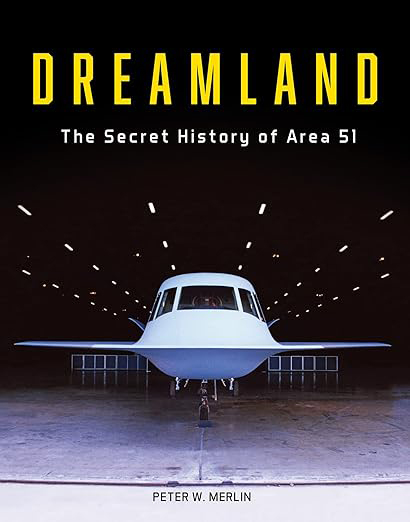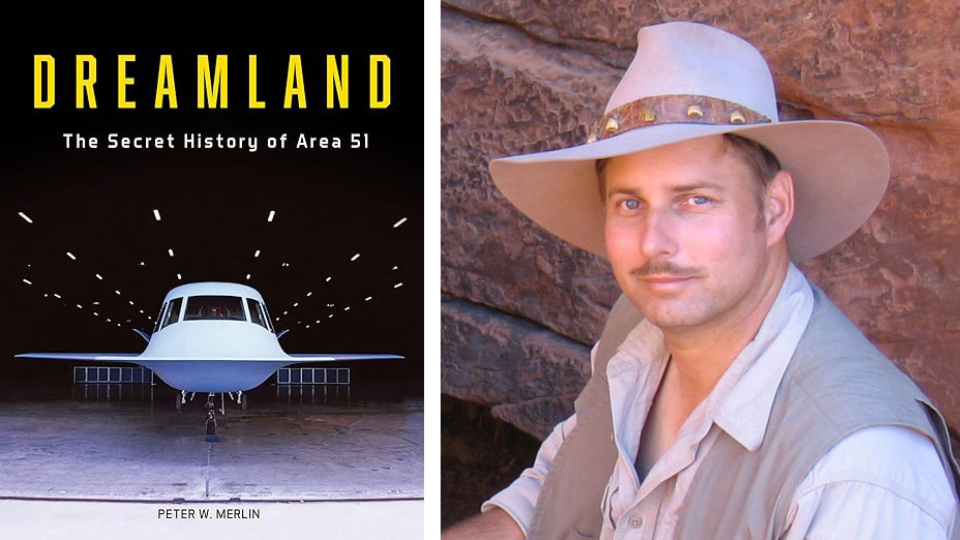The truth is out there.
Aviation historian and Embry-Riddle alumnus Peter Merlin presents it for your consideration in the 560 pages and 700-plus images of “Dreamland: The Secret History of Area 51.” He demystifies a clandestine military base nestled in a remote desert valley north of Las Vegas, now forever lodged in the public imagination.
Merlin (’87) chronicles the testing ground for advanced aviation technologies and cutting-edge weapons with the dogged passion of a conspiracy theorist. However, unlike those who want to believe, he applies the informed and critical perspective of a historian, researcher and photographer.
Growing up as the son of actors in Hollywood, Merlin’s first window into space was the TV screen, where he watched the Apollo moon launches and landings. His interest in airplanes grew in junior high, and discovering Embry-Riddle seemed like the perfect place to learn to fly.

As a student on the Prescott Campus, Merlin built his aerospace cred closer to the forests and mountains of Arizona rather than the remote deserts of Nevada. He joined the flight program, planning a career in aeronautical engineering. However, high-level math and physics posed unsolved mysteries, leading him to switch majors.
Transferring to the Daytona Beach Campus, he completed his degree in Aeronautical Studies and polished his research and writing skills on the student newspaper, The Avion. One of the first classmates he met was Brian Nicklas (’87), now deputy reference chief at the National Air & Space Museum. He won Nicklas over by sharing his personal collection of U.S. Air Force and NASA photos of wingless lifting body research vehicles.
After landing a dream job in the history office at NASA Dryden Flight Research Center, Merlin launched his professional writing career. Recognized as an expert on aerospace history and the crash sites of experimental crafts, he has appeared in documentaries produced by the History Channel, Discovery, National Geographic and Smithsonian.
Hunting Engineering, Not Extraterrestrials
As a student, a book about a U-2 spy plane flown from a secret air base at Groom Lake, Nevada, caught Merlin’s interest. An aerial photo of a huge airfield, long runways and many hangars was labeled “Area 51.” In the pre-internet era, he began collecting articles and books about stealth aircraft, chasing down rumors about the A-12 (predecessor to the SR-71 Blackbird), a Mach 3 airplane that could fly above 80,000 feet, and a rumored “stealth fighter” supposedly invisible to radar.
“Popular culture has attached the whole flying saucer or alien thing to Area 51,” Merlin says, “but that’s not part of the real story.”
Peter Merlin (’87)
Shortly after Merlin graduated with a bachelor’s in Aviation Management, claims by self-described physicist Bob Lazar that he was “reverse engineering flying saucers” at Area 51 grabbed the public imagination (and has never let go even today).
But Merlin was more interested in the engineering than the extraterrestrial, which he sees as a story grafted onto incontestably real research and development.
“Popular culture has attached the whole flying saucer or alien thing to Area 51,” Merlin says, “but that’s not part of the real story.”
Curiosity about flight test programs, coupled with the diligence and determination to go right to the source, has continued to lead him to crash sites of rocket planes and flying wings. He finds what he’s after by poring over declassified materials, studying photos and topographic maps. His searches have taken him to the Mojave Desert and test sites in the Switzerland-sized Nevada Test and Training Range. These investigations have provided the images and insights for more than a dozen books. As his reputation as an “X-Hunter” grew, he began talking with pilots, engineers and their families, patiently and persistently piecing together the truth of Area 51, separating fact from science fiction.
His detective work has gotten easier, thanks to both his expanding network and emerging technology. “Google Earth has been a wonderful tool. Sometimes you can see an impact crater right in the image. That sure would have been useful earlier.”
Does He Want to Believe?
Merlin’s position on little green men or Greys is open-minded.
“It’s a big universe. If you consider the billions of stars in the galaxy and the billions of galaxies in the universe, there could be intelligent life somewhere,” he says. “The question becomes what’s the likelihood that any of that life has come here? And, that would presuppose that they developed space travel and that they would have any desire to go looking for other civilizations. What are the chances they’d be close enough to our planet to want to come here? It seems highly unlikely that all of those things would line up together.”
However, he did make a pilgrimage to Roswell that led to a discovery of a strange, metallic foil.
“Believe me, no person would love to find a flying saucer wreck more than I would, but I’m absolutely satisfied that the Roswell incident is nothing more than a balloon device,” he says.
In fact, when Merlin explored the ranch near Corona, New Mexico, where debris was found in 1947, something caught his eye.
“It’s this rolling terrain that’s pretty gentle. Sheep graze out there, right down to the roots. So there’s virtually no ground cover. The wind is blowing, and anything lightweight can get blown away, but there are sinkholes and rocks here and there. I was looking at a rock and by God, I saw some silver metallic foil! It was a TV dinner tray.”
Despite his skeptic status, Merlin has a keen enough interest in research to help even UFOlogists sharpen their skills. He once gave a presentation at a UFO Crash Retrieval Conference in Las Vegas. “I explained how to find and identify debris at a crash site and showed that the government rarely removes every trace.”
Day Job in Aviation, Side Gig in Exploration
As a member of the Aviation Technologies faculty at Southern Illinois University’s School of Aviation, College of Health and Human Sciences, Merlin stays involved in flight operations. His day job involves intact civil aviation planes rather than the remnants of experimental aircraft.
“We had more than 30 aircraft when I got here, and we just purchased seven new Cessnas. To my surprise, the number of flights we generate with our students turns Southern Illinois Airport into the third busiest airport in the state, after Chicago O’Hare and Midway. We have a lot of flights and we have no radar. So, the air traffic controllers are working visually, which is interesting considering all the traffic they have to deal with and the fact that most of that traffic is students.”
Off-campus, there is more to explore along the Mississippi River and in the Shawnee National Forest. It’s a lot different from California and the West, where he used to hunt for aircraft wrecks. He says that within a 150-mile radius of Edwards Air Force Base, there are 700-plus logged crash sites of military manned and unmanned craft, dating back to the 1930s. During the 1990s, he searched for many of them with fellow aviation enthusiast Tony Moore.
There are a few that got away – at least so far.
“There was a U-2 up in the Tehachapi Mountains that I never found, even with a map,” he recalls. “The X-5 out on the bombing range at Edwards, we came close to that, but never did quite find it. But we found all the ones we really wanted, the X-15, the X-2, the X-1A, the U-2 prototype, the first F-4 Phantom, SR-71 and more … it’s an embarrassment of riches.”
Merlin’s next book may take a decidedly different turn, though perhaps it is consistent with his Indiana Jones adventurer/archeologist persona. “For many years, I’ve been interested in prehistoric rock art, petroglyphs and cave paintings.” This interest has taken him to many fascinating ancient sites in the U.S., Mexico, the United Kingdom and North Africa.
He has donated aviation finds to museums at Edwards Air Force Base and Central Intelligence Agency headquarters. Debris from a hydrogen bomb went to the National Atomic Museum in Albuquerque. Maybe a natural history museum has a display case just waiting for what he discovers next.
